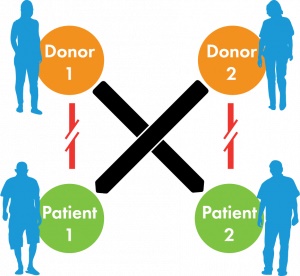Living Kidney Donation
The national wait time for a deceased donor kidney transplant can be as long as six years. Living donations significantly decrease the wait time for patients in need of a kidney transplant.
Having a living kidney donor helps ensure that patients are in better health during transplant surgery by reducing their wait. It also helps people waiting for deceased donor kidneys by lowering the number of people on the waiting list.
Living donation does not change life expectancy for the donor, who can continue to lead a normal life after recovery from the surgery. Studies have shown that one kidney is enough to keep the body healthy by removing waste and excess fluid from the blood.
About Living Kidney Donation
Living donation takes place when a person donates a kidney to someone in need of a transplant. The donor is often a close family member such as a parent, child or sibling, but can also be a spouse, more distant family member or friend.
We offer robotic-assisted donor nephrectomies using advanced robotic surgical systems, an innovative procedure that greatly improves the surgical experience for the donor. Patients experience much less pain post-surgery, and typical in-hospital recovery time is only two to three days. Many donors report feeling well within days and return to work within two to three weeks after the surgery.
We also offer our Gumenick Suites for living donors during their inpatient stay. The Gumenick Suites are located in the Main Hospital, 9th floor, adjacent to our dedicated inpatient unit. As a Gumenick Suites guest, living donors will enjoy advantages that aid in peace of mind and comfort, such as higher nurse-to-patient ratios plus gourmet meals.
It’s the least we can do for these heroes.
During the transplantation, the donor and recipient each have their own surgical team and are in adjacent operating rooms.
In the donor’s operating room, surgeons remove the kidney that will be utilized for donation. Hume-Lee surgeons use minimally invasive surgical techniques. This means that many of our donors can expect smaller incisions and a quicker recovery time.
In the recipient’s operating room, surgeons prepare to immediately transplant the donated kidney.
The dual surgery process takes 10 to 12 hours. Most living kidney donors stay in the hospital an average of two to three days after the donation procedure and have an additional two to four weeks of recovery time.
Living kidney transplantation has many advantages over kidney transplantation from a deceased donor.
Since the living kidney donor is often a close relative of the person getting the transplant, there is a better chance of a good genetic match and less chance of rejection. As a result, living donor kidneys tend to last twice as long as deceased donor kidneys. Also, lower doses of immunosuppressive drugs may be used with fewer side effects.
Other benefits include:
- The transplant can be scheduled ahead of time, something that cannot be done if the recipient is on a waiting list for a deceased donor kidney transplant. This allows the recipient to plan for absences from work, child care and other obligations.
- Kidneys that come from living donors generally begin to function immediately after the transplant, while deceased donor kidneys may take several days or weeks before they begin to function normally.
- Kidneys from living donors don’t need to be transported from one site to another, so the kidney is in better condition when it is transplanted.
Mother and son describe their experience of living organ donation, and how it strengthened their already close bond.
What is a Paired Kidney Donation or Kidney Swap?
If you need a kidney and have a family member or friend willing to donate one of his or her kidneys, but it cannot be done due to tissue or blood type incompatibilities, we have a potential solution.
A paired kidney exchange, also known as a “kidney swap” occurs when a living kidney donor is incompatible with their recipient, but does match another person on the waitlist. In this instance, two live donor transplants can occur.
Suppose there are two donor/recipient pairs, Donor and Recipient 1 and Donor and Recipient 2:
- Donor 1 will give a kidney to Recipient 2
- Donor 2 will then give a kidney to Recipient 1
Paired Kidney Donation Program
Our Paired Kidney Donation Program is aimed at providing increased transplant opportunities for patients on the kidney waitlist. This paired kidney donation transplant enables two incompatible recipients to receive healthy, more compatible kidneys. We also coordinate kidney exchange chains, in which one altruistic donor can kick off a series of transplants between donor/recipient pairs, either completely within Hume-Lee or in collaboration with other transplant centers across the nation.
We are pleased to partner with national kidney exchange programs such as the National Kidney Registry and Alliance for Paired Donation to offer these options to our patients. These are national programs and centers from across the United States have patients enrolled in their databases. In almost all cases the donor and recipient remain at their home Transplant center and travel is not required.
Living Kidney Donor Evaluation
If you know of someone in need of a kidney transplant or are interested in becoming a living kidney donor, you are invited to complete our online Living Kidney Donor Evaluation. Once this easy-to-use online form is completed the information will be securely sent to our living donor intake team.
Begin the living kidney donor evaluation
If you would like more time or information before completing your evaluation form, please explore the resources available on this website.
To learn more about living organ donation, please call (804) 828-2762 to speak to our living donor patient concierge representative.


